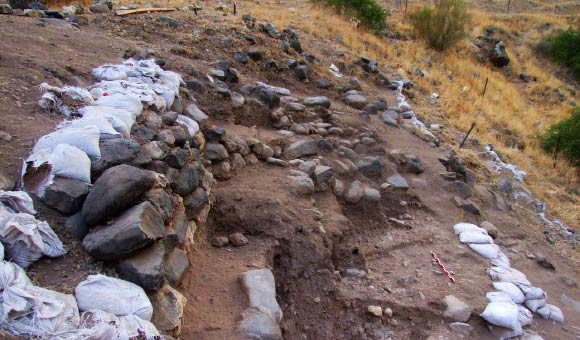12,000-Year-Old Natufian Village Unearthed in Jordan Valley
A prehistoric village has been discovered in the Jordan Valley dating back 12,000 years, according to a report from The Hebrew University.
NEG II is located in Wadi Ein-Gev, west of the Sea of Galilee and south of the Golan Heights town of Katzrin (three acres).
After several excavations, archaeologists discovered a large human settlement including burial remains, flint tools and artefacts.
Read also: Roadside dig Reveals 10,000 Year Old House In Israel
Archaeologists at The Hebrew University of Jerusalem claimed NEG II was exceptional in that it contained cultural features indicative of both the Old Stone Age (Paleolithic) and New Stone Age (Neolithic).
Dr Leore Grosman, the chief excavator at NEG II, said that although the site’s stone tool kit places it in the Paleolithic period, other characteristics, such as its artistic tradition, size, the thickness of archaeological deposits, and investment in architecture, are more typical of Neolithic agricultural communities.
To understand the socio-economic dynamics that characterised the change from Paleolithic mobile civilizations of hunter-gatherers to Neolithic farming communities, it is necessary to characterise this significant era of possible overlap in the Jordan Valley.
Historically, the Paleolithic epoch is regarded to be one of humanity’s earliest periods.
The end of the period is marked by the shift to agricultural civilizations with the appearance of established communities and the domestication of plants and animals.
Read also: The oldest non-African modern human fossil was revealed to be 195,000 years old
Grosman suggests that NEG II was populated during the Younger Dryas, a period of extreme cold and dry weather that affected most of the northern hemisphere between 12,900 and 11,600 years ago.
Due to climate change, groups in the area were more nomadic and smaller in size, she added.
In the Jordan Valley, however, NEG II suggests that some tribes grew in size and chose town-like settlements over a nomadic existence.
Prehistoric man’s final moves toward agriculture in the southern Levant may have been influenced by climatic circumstances.
At a number of sites in the Jordan Valley, Grosman remarked, “it’s not unexpected that we discover a cultural entity that crosses the crossroads between Paleolithic foragers and Neolithic farmers”
Read also: Archaeologists discover a 6th-century coin hoard in ancient Phanagoria




